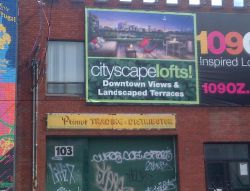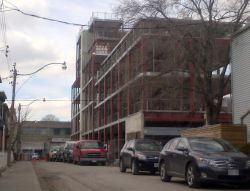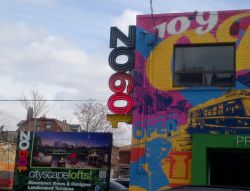Toronto Media Co-op
Local Independent News
Ossington's Gentrification and the New Anglo-Elite Hegemony in Toronto
There is so much hypocrisy, racism and reactionary political maneuvering involved in the gentrification process in Toronto and Ossington in particular that it isn’t at all over-exaggerating to say that that this process has been part of a fascist power game on the part of the city’s traditional Anglo elite to regain the entire downtown of the city from the nuissance of the working class and immigrants as well as dangerous forms of urbanity that they associate with these people. Apparently, for these Anglo elites and the elites of other ethnicities who live by their norms, Ossington north of Queen and south of Dundas was considered a ‘no-go’ zone for a time after its de-industrialization and before the gentrification process got started due to the presence of ‘dangerous street people’, drug addicts, grow-ops, ‘crazies’ associated with CAMH and immigrants running ‘shady’ businesses. However, what these clueless elites don’t realize is that the Ossington’s old Portuguese immigrants are the ones who made it an attractive area for artists, not just because of low rent after its deindustrialization, but because of the vibrant street-life, restaurants, bars and general neighbourhood culture they had already created despite (actually because of) the lack of many Anglo-bourgeois residents, who are probably the least capable of creating interesting culture of any social group.
In most mainstream commentaries on the gentrification of Ossington Avenue, the debate is framed as being between early gentrifiers who bought older houses in the area several years back and new gentrifiers buying into the new condos and townhomes being developed along the strip by Reserve Properties on two different sites. On this basis, it is easy to argue that what the anti-gentrification crowd is really against isn’t gentrification at all but simply new gentrifiers, with all anti-gentrificaiton activism thus being framed as reactionary, backwards, NIMByistic and against change in general. Also, this framing of the debate generally portrays the working class and immigrant communities who traditionally inhabited Ossington (mostly Portuguese before the 90s and Vietnamese immigrants after) as being incapable of any political action or ideas and as somehow outdated relics, much like the businesses associated with their working class life-worlds.
What you can quickly gather from walking along the Ossington strip and through the residential streets is that it once served as a very vibrant working class area with many social, economic and recreational opportunities for workers. From the 1960s to 1990s, the area was a thriving industrial and residential area for predominantly Portuguese immigrants, though the general trend of deindustrialization hit the area hard in the 1990s, leaving many factories and associated businesses closed and opening up the area to cultural producers looking for cheap space and early gentrifiers in the form of both home-buyers and businesspeople looking to get in early on the increasingly hip Queen West at a bargain price. For some of the early gentrifiers who built up the area culturally as an attraction for future large investment, the 1990s and 2000s must seem like the glory days of the Ossington strip when there were opportunities for experimentation and when many of the old working class Portuguese and Vietnamese immigrants were still a dominant presence in the area, as well as the homeless and drug addicts who became prominent in the 90s and early 2000s. Today, these vanguard gentrifiers find themselves in an odd contradiction with less urban and more conservative gentrifiers who want to basically wipe out the real urban history of the area and make it into a sanitized entertainment environment or simulation of a hip urban arts area without the grow-ops, drug addicts, illegal businesses, ‘low value’ land uses, immigrants and homeless people.
The difference with the recent intensifying of the gentrification of Ossington since 2008 is that it is beginning to threaten the very existence of any working class immigrant residences, immigrant-serving shops and light manufacturing businesses in the area, with a real tipping point coming soon when the senior residents of the area pass away and their families have to sell their homes. You can read comments online about how the area still isn’t gentrified enough and that there is still a lot of room for development, basically saying in a very nice way that the old Portuguese, Italian, Ukrainian and Vietnamese residents and workers and the economies associated with their daily lives are still a nuisance in the area that needs to be cleaned up, though with Little Portugal signs remaining up and one or two token businesses and churches remaining just for quaintness. The hypocritical thing about the critiques of working class and immigrant land uses by the new gentrifier douchebag condo elite is that if they used the land for these same purposes with different branding (cafes, bars, restaurants, workspaces for artisans, storage space, car repair) or if the immigrant workers had developed some of the new businesses they have (gyms in the back of cafes, late-night bars, clothing stores), they would still say that they are creating innovative, lively and creative urban cultures and spaces and that the area used to be a derelict area in need of rejuvenation or some such bullshit. While not all of these gentrifiers are Anglo or even white, they have taken on the ideology of the city’s Anglo elite in denigrating immigrant working class culture as lesser and adhering to the new suburbanized downtown condo aesthetic of a hip urban life without the ‘drama’ of actually having to live in a gritty urban area with ‘urban’ problems. Fuck them and their dystopian dreams.
About the poster
The site for the Toronto local of The Media Co-op has been archived and will no longer be updated. Please visit the main Media Co-op website to learn more about the organization.


